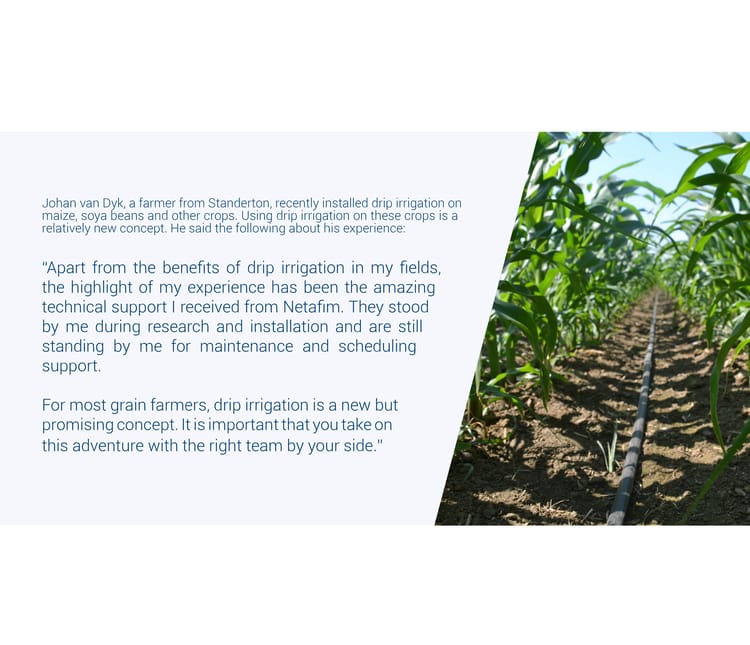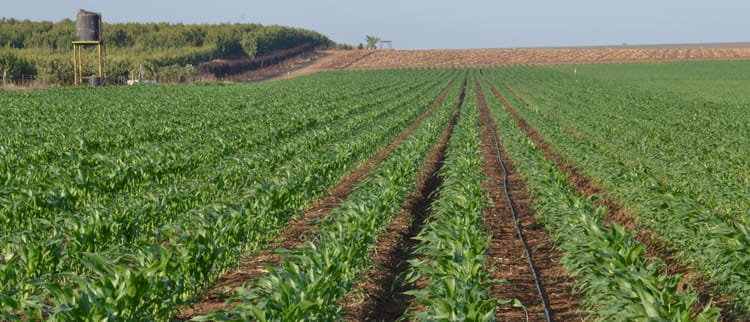Manage risk with efficient irrigation
Season after season, grain producers are confronted by various risks. Be it climate-related or caused by a price-cost squeeze threatening the industry. When asked why he decided to install subsurface drip irrigation on his farm, Danie Minnaar of the farm, Springboklaagte in the Kroonstad regions says the following: “I am not a farmer, I am a risk manager. My job is to find ways to reduce risk in my farming activities. Subsurface drip irrigation is one of my risk management tools.”
Drip irrigation is a proven practice in many agricultural industries. It is however a relatively new concept in the South African grain industry. Netafim South Africa is involved in various trials to test both on-surface and subsurface drip irrigation on maize, soya beans, grazing crops and more. Results to date are quite positive, and we will share these results with the industry as soon as they are available. As part of a global company, we also have the advantage of knowledge gained from the successful use of drip irrigation on grain crops in many other countries.
Efficient and accurate
“We believe that drip irrigation can have a substantial impact on the local grain industry,” says Michael Esmeraldo, agronomist and sales manager for Netafim South African in the Northern Region. “It is about increasing profit margins by helping farmers save money through reduced input costs, reduced labour requirements and more. Each producer must determine whether drip irrigation can work on his farm and whether the investment will be worthwhile. If you want to use water and fertiliser as efficiently as possible, you must consider whether drip irrigation can work for you.”
Drip irrigation’s accurate application of water and fertiliser brings about not only reduced costs and resource requirements, but also potentially higher yields. “We have to understand that the conversation in the grain industry must not be focussed on higher yields alone. We must talk about ways to ensure that farms can be financially sustainable.” This is where Netafim believes drip irrigation can help the industry.
Reduced water and fertiliser costs, maintenance costs, labour costs as well as lower electricity, diesel and other input costs increases profit margins. The impact of the cost-price squeeze is counteracted, and farmers can collect higher profit, whether yields increase or not. As farmer, you have no control over climate and price related risks. By reducing input costs, you can however limit the impact of these threats.
Because grain production is extremely weather dependent, fluctuating yields is one of the major risks faced by grain farmers. By implementing drip irrigation, you can stabilise yields and remove one uncertainty from the equation.
Benefits of drip irrigation
Drip irrigation makes irrigation more accessible as it can be installed on fields of any shape, size or topography. “It is the perfect irrigation solution for fields where other methods of irrigation, such as pivots or sprinklers, cannot be used,” says Michael.
Drip irrigation delivers water and fertiliser directly to the root-zone of each plant. This increases efficiency and means that not even a drop of these costly resources is wasted. “Increased water-use efficiency is an important priority in modern farming practices. Through drip irrigation you can increase water-use efficiency to maintain yields in drought circumstances, increase yield per hectare or to irrigate more hectares with the water available to you.”
Various irrigation strategies are implemented with drip irrigation. The suitable strategy will be dependent on the crop, climate, soil type and other factors. Strategies range from supplementary irrigation to replenish subsoil moisture content to daily intensive irrigation. The selected strategy will further determine the approach to fertiliser application. Michael explains the fact that nutrients can be delivered through the irrigation system is a major benefit. “This allows us to apply fertiliser more frequently and in smaller doses. It is no longer necessary to apply all fertiliser at once at the start of the season. It further allows the farmer to adapt fertiliser application throughout the season.”
Will it work for me?
A host of factors must be considered to determine whether drip irrigation will work on your farm. You will also have to make decisions around delivery rates, spacing, scheduling and more.
Consider the following factors:
- Irrigation and production goals
- Availability of water – quality and quantity
- Soil type and depth
- Reliability and availability of electricity
- Tilling practices – subsurface drip irrigation and modern implements make drip irrigation compatible with tillage practices
- Crop and cultivar – high yield irrigation cultivars
- Cover/Rotation Crops
- Topography – this will determine whether pressure-compensating dripper will be necessary.
Drip irrigation can have a very positive impact on your farm. Danie says it best: “If you have good soil and a limited but secure water source, I believe drip irrigation can be an excellent solution.”



Share your thoughts
Comments
We'd love to hear your thoughts! To enter a comment, type your name and email address.